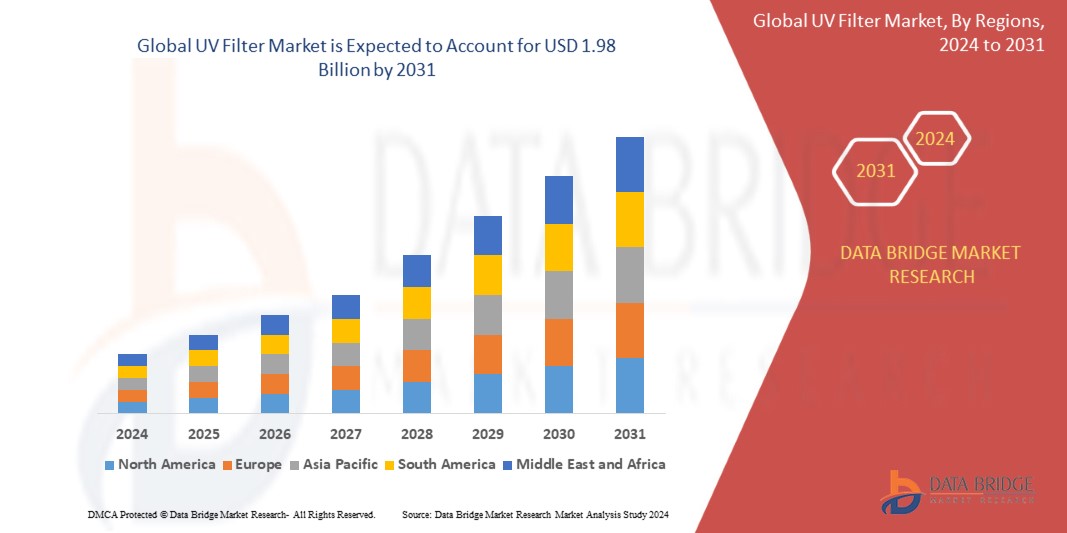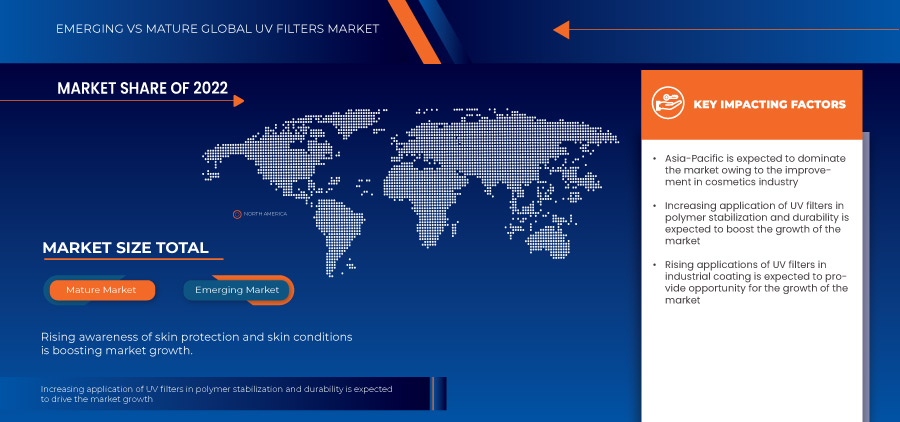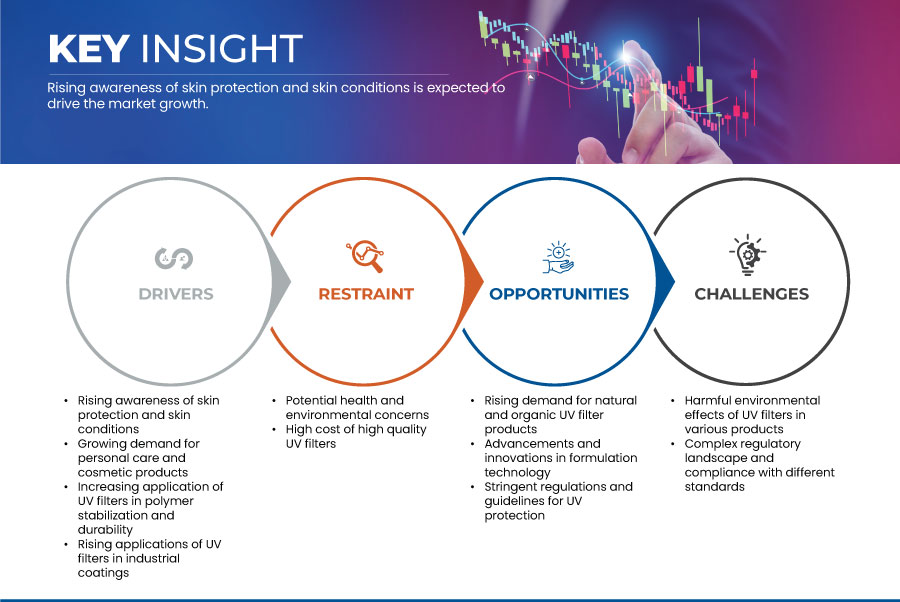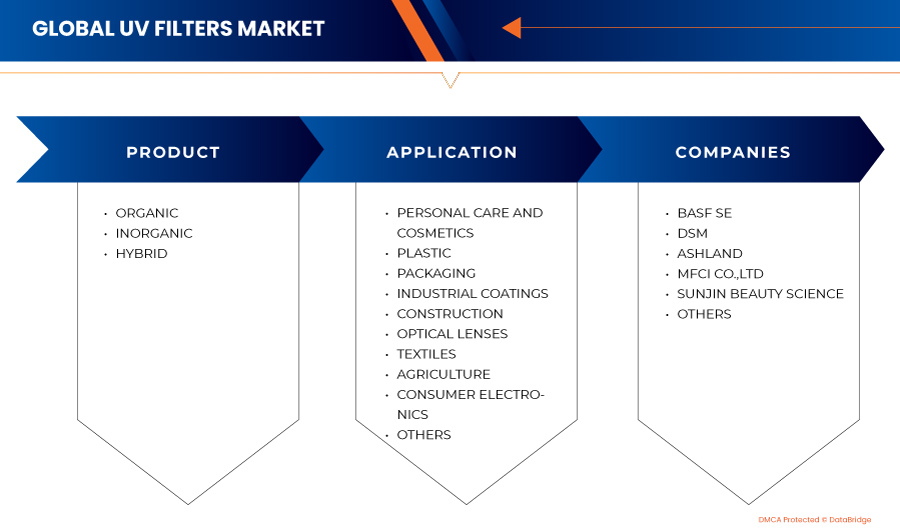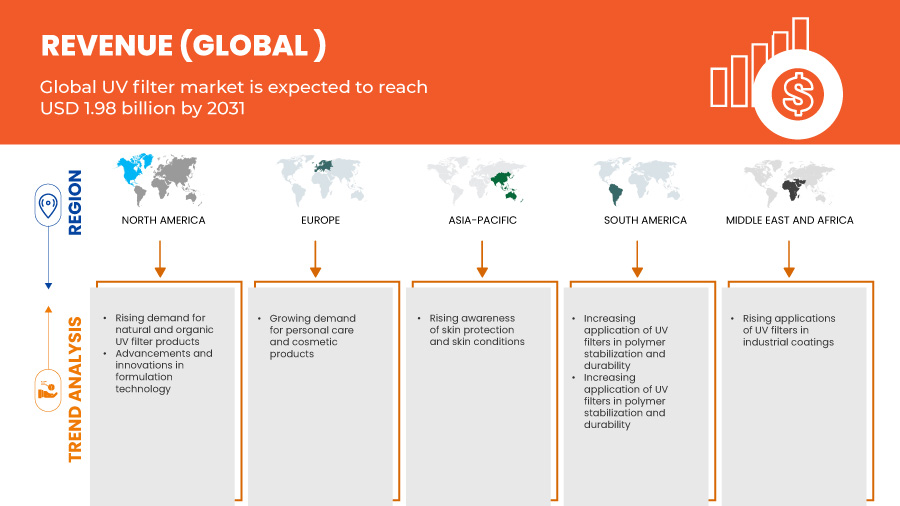Global Uv Filter Market
Marktgröße in Milliarden USD
CAGR :
% 
 USD
1.53 Billion
USD
2.04 Billion
2024
2032
USD
1.53 Billion
USD
2.04 Billion
2024
2032
| 2025 –2032 | |
| USD 1.53 Billion | |
| USD 2.04 Billion | |
|
|
|
Global UV Filter Market, By Product (Organic, Inorganic, and Hybrid), Application (Personal Care and Cosmetics, Plastic, Packaging, Industrial Coatings, Construction, Optical Lenses, Textiles, Agriculture, Consumer Electronics, and Others) – Industry Trends and Forecast to 2031.
UV Filter Market Analysis
UV Filter has a rapid growth in expanding the skincare industry has responded to this heightened awareness by innovating and improving UV filter formulations. Companies are investing in research and development to create more effective, long-lasting, and user-friendly UV protection products. The cosmetic industry is rapidly evolving, with a strong focus on developing products that offer additional benefits beyond basic skincare. UV filters are now being incorporated into a wide range of products, including moisturizers, foundations, and lip balms, to provide comprehensive sun protection. This trend is particularly prominent in regions with high UV exposure, where consumers are more likely to seek out products with built-in UV protection. thereby driving market growth globally.
UV Filter Market Size
Global UV filter market size was valued at USD 1.49 billion in 2023 and is projected to reach USD 1.98 billion by 2031, with a CAGR of 3.64% during the forecast period of 2024 to 2031.
UV Filter Market Trends
“Rising Applications of UV Filters In Industrial Coatings”
UV filters are increasingly utilized in industrial coatings to protect surfaces from ultraviolet (UV) radiation, which can cause degradation, discoloration, and reduced lifespan of coatings. As industries seek to enhance the durability and longevity of their products, the demand for UV filters has surged. These filters are essential in providing a protective barrier that prevents UV-induced damage, making them a critical component in the formulation of high-performance coatings.
Examples of the construction industry also contributes to the growing demand for UV filters in coatings. Architectural coatings used on building exteriors are exposed to varying weather conditions, including intense UV radiation. By incorporating UV filters into these coatings, manufacturers can offer products that resist fading and maintain their protective qualities over extended periods. This application of UV filters is becoming increasingly crucial as building owners and developers prioritize long-lasting and low-maintenance solutions. In addition, the consumer goods sector, including electronics and household appliances, benefits from UV filters in coatings. Electronic devices and appliances often feature coatings that protect against UV damage, ensuring that their appearance and functionality remain intact. As the market for durable and aesthetically appealing consumer goods grows, the need for UV filters in these coatings expands. This demand is supported by technological advancements and increasing consumer expectations for high-quality products.
Report Scope and Market Segmentation
|
Attributes |
UV Filter Key Market Insights |
|
Segments Covered |
By Product: Organic, Inorganic, and Hybrid By Application: Personal Care and Cosmetics, Plastic, Packaging, Industrial Coatings, Construction, Optical Lenses, Textiles, Agriculture, Consumer Electronics, and Others |
|
Countries Covered |
U.S., Canada, and Mexico, Germany, France, U.K., Italy, Russia, Spain, Netherlands, Belgium, Sweden, Switzerland, Poland, Norway, Denmark, Turkey, Finland, Rest of Europe, China, Japan, South Korea, India, Australia, Indonesia, Thailand, Malaysia, Vietnam, Philippines, Singapore, New Zealand, Taiwan, Rest of Asia-Pacific, Brazil, Argentina, Rest of South America, U.A.E., Saudi Arabia, South Africa, Egypt, Kuwait, Qatar, Oman, Bahrain, and Rest of Middle East and Africa |
|
Key Market Players |
BASF SE (Germany), DSM (Netherlands), Ashland (U.S.), MFCI CO.,LTD (China), SUNJIN BEAUTY SCIENCE (South Korea), EverCare (U.S.), Sarex (India), UNIPROMA Hot Products (U.K), Omega Optical, LLC. (U.S.), and IRA Istituto Ricerche Applicate S.p.A. (Italy) |
|
Market Opportunities |
|
|
Value Added Data Infosets |
In addition to the insights on market scenarios such as market value, growth rate, segmentation, geographical coverage, and major players, the market reports curated by the Data Bridge Market Research also include import export analysis, production capacity overview, production consumption analysis, price trend analysis, climate change scenario, supply chain analysis, value chain analysis, raw material/consumables overview, vendor selection criteria, PESTLE Analysis, Porter Analysis, and regulatory framework. |
UV Filter Market Definition
UV filters are compounds used to block or absorb ultraviolet (UV) radiation. They are commonly found in sunscreens, cosmetics, and various skincare products. These filters protect the skin from harmful UV rays, which can cause sunburn, premature aging, and skin cancer. UV filters are classified into two main types: chemical absorbers and physical blockers. Chemical absorbers absorb UV radiation and convert it into harmless heat. Physical blockers, like zinc oxide and titanium dioxide, reflect and scatter UV rays away from the skin. Their use is essential for maintaining skin health and preventing UV-induced damage.
UV Filter Market Dynamics
Drivers
- Rising Awareness of Skin Protection and Skin Conditions
The skincare industry has responded to this heightened awareness by innovating and improving UV filter formulations. Companies are investing in research and development to create more effective, long-lasting, and user-friendly UV protection products. These advancements are crucial as consumers look for products that not only provide high SPF protection but also cater to different skin types and preferences, such as water-resistant and non-greasy formulations. This innovation is driving the market forward, as more consumers integrate UV protection into their daily skincare routines. Moreover, regulatory bodies worldwide are implementing stricter guidelines for UV protection in skincare products, ensuring that products on the market are both safe and effective. These regulations are compelling manufacturers to enhance their UV filter offerings, thereby boosting market growth. The increasing scrutiny and demand for transparency in product formulations are pushing companies to use high-quality, compliant ingredients, which further fuels the expansion of the UV filter market.
For instance,
- In July 2024, in according to an article published by MJH Life Sciences, World Skin Health Day was inaugurated by the International League of Dermatological Societies (ILDS) and the International Society of Dermatology (ISD). The event aimed to promote "Skin Health for All" with global activities. CeraVe, the first official corporate partner, supported initiatives worldwide to enhance skin health education and access. Events included free consultations in Malta, a skin cancer program in Tanzania, and educational sessions in Canada and Australia. The day marked a significant step towards addressing barriers to dermatological care globally
Growing Demand for Personal Care and Cosmetic Products
The cosmetic industry is rapidly evolving, with a strong focus on developing products that offer additional benefits beyond basic skincare. UV filters are now being incorporated into a wide range of products, including moisturizers, foundations, and lip balms, to provide comprehensive sun protection. This trend is particularly prominent in regions with high UV exposure, where consumers are more likely to seek out products with built-in UV protection. Advancements in UV filter technology are also playing a crucial role in market growth. Manufacturers are investing in research and development to create more efficient and stable UV filters that provide broad-spectrum protection. These innovations not only enhance the efficacy of personal care and cosmetic products but also address consumer concerns about potential side effects and environmental impact.
For instance,
- In July 2024, according to article published by Cision US Inc., A new study by Veylinx revealed consumer preferences for sunscreen, highlighting increased demand for products with added benefits like anti-aging (+49%), hydration (+33%), and vitamin C (+23%). Consumers showed a willingness to pay more for these enhanced features. The study also noted rising "sunxiety," with 38% feeling uneasy in the sun and a significant percentage burning easily. Usage trends indicated 30% applied sunscreen daily in summer, while 65% preferred SPF greater than 40
Opportunities
- Rising Demand for Natural And Organic UV Filter Products
Consumers are increasingly seeking products made with natural ingredients due to growing awareness about the potential health and environmental impacts of synthetic chemicals. This shift in consumer preference is driven by a desire for safer, eco-friendly, and sustainable products. Natural and organic UV filters often use plant-based or mineral ingredients like zinc oxide and titanium dioxide, which are perceived as safer and more environmentally friendly.
For instance,
- In July 2024, according to an article published by UL LLC, consumers are placing greater emphasis on transparency and clean beauty in their skincare products. In response, sunscreen brands are removing problematic ingredients such as oxybenzone and octinoxate, which have been associated with environmental and health issues. Clean formulations focus on natural and organic ingredients that are safe for both skin and the environment, in line with the clean beauty trend
- Advancements And Innovations In Formulation Technology
Improved formulation techniques enhance the effectiveness, stability, and sensory attributes of UV filters, making them more attractive to both manufacturers and consumers. New technologies enable the development of UV filters that offer better protection against a broader spectrum of UV radiation. Innovations such as encapsulation techniques help improve the stability and longevity of UV filters in various products, ensuring they remain effective throughout their intended use.
For instance,
- In July 2024, according to a blog published by Let's Make Beauty by Presperse, encapsulation technology offers excellent flexibility, enabling its use in various cosmetic products to improve their performance, stability, and user experience. Encapsulating UV filters can boost a product's photo stability and comfort, minimize potential skin irritation, and enhance protection against harmful sun exposure
Restraints/Challenges
- Potential Health and Environmental Concerns
Certain UV filters, such as oxybenzone and octocrylene, have raised concerns due to their potential health impacts. Research has indicated that these compounds may have endocrine-disrupting effects, which can interfere with hormonal systems in humans. This has led to increased scrutiny and regulation, as consumers become more aware of the potential risks associated with these chemicals. Consequently, the demand for UV filters is impacted by the growing preference for products with safer, more natural ingredients.
Environmental issues also contribute to the restraint on the UV filter market. Many UV filters have been found to have harmful effects on marine ecosystems. For example, some chemicals can contribute to coral reef bleaching and disrupt aquatic life, leading to adverse environmental impacts. This has led to stricter regulations and bans on certain UV filters in various regions, particularly in places with sensitive marine environments. These ecological concerns result in increased regulatory compliance costs and limit the market's ability to use certain UV filters, impacting overall market growth.
For instance,
- In September 2021, According to an article published by Environmental Working Group, the FDA proposed updating sunscreen regulations, determining only zinc oxide and titanium dioxide as “generally recognized as safe and effective” (GRASE). Other ingredients, including oxybenzone and octinoxate, faced scrutiny for safety and were not classified as GRASE due to insufficient data. Concerns arose over systemic absorption, hormone disruption, and potential health risks. European standards differed, proposing stricter limits for some non-mineral UV filters. The FDA requested more safety data for these ingredients while allowing their continued use in the U.S. market
High Cost of High-Quality UV Filters
For industrial applications, such as in automotive and architectural coatings, the cost of high-quality UV filters can be a significant barrier. These filters are crucial for enhancing the durability and performance of coatings by preventing UV-induced degradation. However, the high cost can lead to increased production costs for manufacturers, which might deter them from using premium filters. As a result, the market may see slower growth in sectors where cost constraints are a critical factor. Additionally, the high cost of advanced UV filters can restrict innovation and the development of new products within the market. Manufacturers might be hesitant to invest in research and development of novel UV filter technologies if the high costs make it challenging to achieve a return on investment. This reluctance can slow down the introduction of new and improved UV filters, further stalling market progress.
Climate Change Scenario
The global UV filter market faces significant environmental concerns, particularly regarding the impact of certain UV filters on marine ecosystems. Ingredients such as oxybenzone and octocrylene have been linked to coral reef degradation, harming coral health and disrupting aquatic life due to their toxic effects. In response to environmental and health concerns, the global UV filter market is undergoing significant changes. The industry is shifting towards safer, eco-friendly alternatives to traditional UV filters like oxybenzone and octocrylene, which have been linked to coral reef damage and other environmental issues. Governments play a pivotal role in shaping the global UV filter market through regulation, policy-making, and enforcement. They establish regulations and safety standards for UV filters to protect consumers, setting limits on concentrations and defining efficacy and safety profiles, as seen with agencies like the U.S. FDA and the European Commission. Analysts recommend several strategic approaches for the global UV filter market to address current challenges and leverage emerging opportunities. Firstly, shifting towards eco-friendly alternatives is crucial due to increasing environmental concerns about traditional UV filters like oxybenzone and octocrylene, which have been linked to coral reef damage. Adopting biodegradable and reef-safe ingredients can help companies align with regulatory trends and meet consumer demand for sustainable products
Regulatory Framework content
Regulations play a crucial role in the UV Filter market, ensuring product quality, safety, and environmental compliance throughout the manufacturing process, For UV systems used in water treatment, adherence to Environmental Protection Agency (EPA) guidelines ensures that the UV systems effectively inactivate pathogens and meet safety standards. Regulations on waste disposal and recycling vary by region, requiring manufacturers to implement proper waste management practices to minimize environmental impact.
Below is a detailed coverage of regulations and standards affecting the global UV Filter market:
Europe
Regulation (EC) No 1223/2009
- UV filters used in cosmetics must be approved and listed in Annex VI of Regulation (EC) No 1223/2009. This annex specifies which UV filters can be used, their maximum allowable concentrations, and any specific conditions of use
- Before a UV filter can be included in Annex VI, it must undergo rigorous safety evaluations. This includes toxicological testing to ensure it does not pose a risk to human health when used as intended.
- Products containing UV filters must demonstrate their effectiveness in protecting against UV radiation. This typically involves standardized testing methods for SPF (Sun Protection Factor) and UVA protection
- Sunscreens and other products containing UV filters must include appropriate labeling, which includes:
SPF Value: Indicates the level of UVB protection.
UVA Protection: Must include a UVA logo or statement if the product offers UVA protection.
Directions for Use: Instructions on how to apply the product effectively.
Warnings: Any specific warnings related to sun exposure and use of the product.
United States
21 CFR Part 352 :
- It includes a list of UV filters that are generally recognized as safe and effective for use in sunscreens. These filters are categorized into two types:
Chemical UV Filters: These include ingredients like:
- Avobenzone (Butyl Methoxydibenzoylmethane): Provides broad-spectrum UVA protection.
- Octocrylene: Used to stabilize other UV filters and provides UVB protection.
- Octinoxate (Ethylhexyl Methoxycinnamate): Absorbs UVB rays.
- Oxybenzone: Provides UVB and some UVA protection.
- Homosalate: Absorbs UVB rays.
Physical (Mineral) UV Filters: These include ingredients like:
- Titanium Dioxide: Provides broad-spectrum protection, including UVA and UVB.
- Zinc Oxide: Also provides broad-spectrum protection.
The UV energy required to produce an MED on protected skin divided by the UV energy required to produce an MED on unprotected skin, which may also be defined by the following ratio: SPF value = MED (protected skin (PS))/MED (unprotected skin (US)), where MED (PS) is the minimal erythema dose for protected skin after application of 2 milligrams per square centimeter of the final formulation of the sunscreen product, and MED (US) is the minimal erythema dose for unprotected skin, e., skin to which no sunscreen product has been applied. In effect, the SPF value is the reciprocal of the effective transmission of the product viewed as a UV radiation filter.
Production Cost Scenario
Laut unserer Analyse betragen die durchschnittlichen Produktionskosten für UV-Filter 15,23 USD pro kg. Die durchschnittlichen Produktionskosten für Hersteller sind nicht konstant, sie hängen von verschiedenen Faktoren ab oder sind variabel. Laut unserer Analyse beträgt die durchschnittliche Produktion von UV-Filtern im Jahr 2023 87.409,07 Tonnen und wird voraussichtlich im Jahr 2031 104.410,50 Tonnen erreichen. Der durchschnittliche Verbrauch beträgt im Jahr 2023 80.320,19 Tonnen und wird voraussichtlich im Jahr 2031 99.200,41 Tonnen erreichen.
Auswirkungen von Rohstoffknappheit und Lieferverzögerungen und aktuelles Marktszenario
Data Bridge Market Research bietet eine umfassende Marktanalyse und liefert Informationen, indem es die Auswirkungen und das aktuelle Marktumfeld von Rohstoffknappheit und Lieferverzögerungen berücksichtigt. Dies bedeutet, dass strategische Möglichkeiten bewertet, wirksame Aktionspläne erstellt und Unternehmen bei wichtigen Entscheidungen unterstützt werden.
Neben dem Standardbericht bieten wir auch detaillierte Analysen des Beschaffungsniveaus anhand prognostizierter Lieferverzögerungen, Händlerzuordnung nach Regionen, Warenanalysen, Produktionsanalysen, Preiszuordnungstrends, Beschaffung, Kategorieleistungsanalysen, Lösungen zum Lieferkettenrisikomanagement , erweitertes Benchmarking und andere Dienste für Beschaffung und strategische Unterstützung.
Erwartete Auswirkungen der Konjunkturabschwächung auf die Preisgestaltung und Verfügbarkeit von Produkten
Wenn die Wirtschaftstätigkeit nachlässt, leiden auch die Branchen darunter. Die prognostizierten Auswirkungen des Konjunkturabschwungs auf die Preisgestaltung und Verfügbarkeit der Produkte werden in den von DBMR bereitgestellten Markteinblickberichten und Informationsdiensten berücksichtigt. Damit sind unsere Kunden ihren Konkurrenten in der Regel immer einen Schritt voraus, können ihre Umsätze und Erträge prognostizieren und ihre Gewinn- und Verlustaufwendungen abschätzen.
Globaler UV-Filter- Marktumfang
Der Markt ist nach Produkt und Anwendung segmentiert. Das Wachstum dieser Segmente hilft Ihnen bei der Analyse schwacher Wachstumssegmente in den Branchen und bietet den Benutzern einen wertvollen Marktüberblick und Markteinblicke, die ihnen bei der strategischen Entscheidungsfindung zur Identifizierung der wichtigsten Marktanwendungen helfen.
Produkt
- Organisch
- Avobenzon
- Octinoxat
- Octocrylen
- Oxybenzon
- Homosalat
- Octisalat
- Ensulizol
- Bis-Ethylhexyloxyphenol Methoxyphenyl Triazine (Bemotrizinol)
- Methylen-Bis-Benzotriazolyl-Tetramethylbutylphenol (Bisoctrizol)
- Drometrizol Trisiloxan
- Meradimat (Menthylanthranilat)
- Octyltriazon (Ethylhexyltriazon)
- Polysilikon-15
- Aminobenzoesäure
- Octyldimethyl-PABA
- Sonstiges
- Anorganisch
- Titandioxid (TIO2)
- Zinkoxid (ZNO)
- Eisenoxid (FE2O3)
- Siliziumoxid (SIO2)
- Tantaloxid
- Sonstiges
- Hybrid
Anwendung
- Körperpflege und Kosmetik
- Sonnenschutz
- BB- und CC-Creme
- Stiftung
- Gesichtscreme
- Lotion
- Lippenbalsam
- Lippenstift
- Shampoos
- Spülung
- Sonstiges
- Kunststoff, Verpackung
- Lebensmittelverpackungen
- Pharmazeutische Verpackungen
- Industrielle Beschichtungen
- Schutzbeschichtungen
- Maschinen
- Rohrleitungen
- Industrielle Ausrüstung
- Sonstiges
- Autolacke
- Klarlack
- Farben
- Scheinwerfer
- Windows
- Windschutzscheibe
- Stoßstangen
- Seitenspiegel
- Trimmen
- Sonstiges
- Konstruktion
- Optische Linsen
- Sonnenbrille
- Brillen
- Kontaktlinsen
- Textilien
- Sport
- Bademode
- Sonstiges
- Landwirtschaft
- Gewächshausfolien
- Schattentücher
- Ernteabdeckungen
- Sonstiges
- Unterhaltungselektronik
- Smartphones
- Monitore
- Fernseher
- Sonstiges
- Sonstiges
- Schutzbeschichtungen
Globale UV-Filter-Marktregionalanalyse
Der Markt ist nach Produkt und Anwendung segmentiert .
Die vom Markt abgedeckten Länder sind die USA, Kanada und Mexiko, Deutschland, Frankreich, Großbritannien, Italien, Russland, Spanien, die Niederlande, Belgien, Schweden, die Schweiz, Polen, Norwegen, Dänemark, die Türkei, Finnland, das übrige Europa, China, Japan, Südkorea, Indien, Australien, Indonesien, Thailand, Malaysia, Vietnam, die Philippinen, Singapur, Neuseeland, Taiwan, der übrige asiatisch-pazifische Raum, Brasilien, Argentinien, das übrige Südamerika, die Vereinigten Arabischen Emirate, Saudi-Arabien, Südafrika, Ägypten, Kuwait, Katar, Oman, Bahrain sowie der übrige Nahe Osten und Afrika.
Aufgrund der großen und weiter wachsenden Bevölkerung, des zunehmenden Bewusstseins für Hautpflege und der steigenden verfügbaren Einkommen wird der asiatisch-pazifische Raum voraussichtlich die dominierende und am schnellsten wachsende Region auf dem Markt sein.
Der Länderabschnitt des Berichts enthält auch Angaben zu einzelnen marktbeeinflussenden Faktoren und Änderungen der Regulierung auf dem Inlandsmarkt, die sich auf die aktuellen und zukünftigen Trends des Marktes auswirken. Datenpunkte wie Downstream- und Upstream-Wertschöpfungskettenanalysen, technische Trends und Porters Fünf-Kräfte-Analyse sowie Fallstudien sind einige der Anhaltspunkte, die zur Prognose des Marktszenarios für einzelne Länder verwendet werden. Bei der Bereitstellung von Prognoseanalysen der Länderdaten werden auch die Präsenz und Verfügbarkeit globaler Marken und ihre Herausforderungen aufgrund großer oder geringer Konkurrenz durch lokale und inländische Marken sowie die Auswirkungen inländischer Zölle und Handelsrouten berücksichtigt.
Globaler UV-Filter-Marktanteil
Die Wettbewerbslandschaft des Marktes liefert Einzelheiten zu den Wettbewerbern. Zu den enthaltenen Einzelheiten gehören Unternehmensübersicht, Unternehmensfinanzen, erzielter Umsatz, Marktpotenzial, Investitionen in Forschung und Entwicklung, neue Marktinitiativen, globale Präsenz, Produktionsstandorte und -anlagen, Produktionskapazitäten, Stärken und Schwächen des Unternehmens, Produkteinführung, Produktbreite und -umfang, Anwendungsdominanz. Die oben angegebenen Datenpunkte beziehen sich nur auf den Fokus der Unternehmen in Bezug auf den Markt.
Die auf dem Markt tätigen Marktführer für UV-Filter sind:
- BASF SE (Deutschland)
- DSM (Niederlande)
- Ashland (USA)
- MFCI CO., LTD (China)
- SUNJIN BEAUTY SCIENCE (Südkorea)
- EverCare (USA)
- Sarex (Indien)
- UNIPROMA Heiße Produkte (Großbritannien)
- Omega Optical, LLC. (USA)
- IRA Istituto Ricerche Applicate SpA (Italien)
Neueste Entwicklungen auf dem UV-Filtermarkt
- Im September 2023 hat BASF die Produktion seines modernen UV-Filterportfolios in der Region Asien-Pazifik weiter ausgebaut. Uvinul A Plus ist einer der wenigen heute auf dem Markt erhältlichen photostabilen UVA-Filter, der die schädlichen UVA-Strahlen der Sonne zuverlässig filtert und vor freien Radikalen und Hautschäden schützt.
- Im März 2023 erweitert DSM das PARSOL-Portfolio mit der Einführung von PARSOL DHHB. PARSOL DHHB bietet Formulierern die Flexibilität, multifunktionale Produkte mit ausreichendem UVA-Schutz und Formulierungen mit hoher Ökoklasse (gemäß DSM Sunscreen Optimizer™ 2.0) zu entwickeln. Seine hervorragende Löslichkeit und breite Formulierungskompatibilität heben PARSOL DHHB von der Masse ab und eignen sich für ein breites Anwendungsspektrum, darunter Sonnenschutzmittel, Gesichtspflege und Farbkosmetik.
SKU-
Erhalten Sie Online-Zugriff auf den Bericht zur weltweit ersten Market Intelligence Cloud
- Interaktives Datenanalyse-Dashboard
- Unternehmensanalyse-Dashboard für Chancen mit hohem Wachstumspotenzial
- Zugriff für Research-Analysten für Anpassungen und Abfragen
- Konkurrenzanalyse mit interaktivem Dashboard
- Aktuelle Nachrichten, Updates und Trendanalyse
- Nutzen Sie die Leistungsfähigkeit der Benchmark-Analyse für eine umfassende Konkurrenzverfolgung
Forschungsmethodik
Die Datenerfassung und Basisjahresanalyse werden mithilfe von Datenerfassungsmodulen mit großen Stichprobengrößen durchgeführt. Die Phase umfasst das Erhalten von Marktinformationen oder verwandten Daten aus verschiedenen Quellen und Strategien. Sie umfasst die Prüfung und Planung aller aus der Vergangenheit im Voraus erfassten Daten. Sie umfasst auch die Prüfung von Informationsinkonsistenzen, die in verschiedenen Informationsquellen auftreten. Die Marktdaten werden mithilfe von marktstatistischen und kohärenten Modellen analysiert und geschätzt. Darüber hinaus sind Marktanteilsanalyse und Schlüsseltrendanalyse die wichtigsten Erfolgsfaktoren im Marktbericht. Um mehr zu erfahren, fordern Sie bitte einen Analystenanruf an oder geben Sie Ihre Anfrage ein.
Die wichtigste Forschungsmethodik, die vom DBMR-Forschungsteam verwendet wird, ist die Datentriangulation, die Data Mining, die Analyse der Auswirkungen von Datenvariablen auf den Markt und die primäre (Branchenexperten-)Validierung umfasst. Zu den Datenmodellen gehören ein Lieferantenpositionierungsraster, eine Marktzeitlinienanalyse, ein Marktüberblick und -leitfaden, ein Firmenpositionierungsraster, eine Patentanalyse, eine Preisanalyse, eine Firmenmarktanteilsanalyse, Messstandards, eine globale versus eine regionale und Lieferantenanteilsanalyse. Um mehr über die Forschungsmethodik zu erfahren, senden Sie eine Anfrage an unsere Branchenexperten.
Anpassung möglich
Data Bridge Market Research ist ein führendes Unternehmen in der fortgeschrittenen formativen Forschung. Wir sind stolz darauf, unseren bestehenden und neuen Kunden Daten und Analysen zu bieten, die zu ihren Zielen passen. Der Bericht kann angepasst werden, um Preistrendanalysen von Zielmarken, Marktverständnis für zusätzliche Länder (fordern Sie die Länderliste an), Daten zu klinischen Studienergebnissen, Literaturübersicht, Analysen des Marktes für aufgearbeitete Produkte und Produktbasis einzuschließen. Marktanalysen von Zielkonkurrenten können von technologiebasierten Analysen bis hin zu Marktportfoliostrategien analysiert werden. Wir können so viele Wettbewerber hinzufügen, wie Sie Daten in dem von Ihnen gewünschten Format und Datenstil benötigen. Unser Analystenteam kann Ihnen auch Daten in groben Excel-Rohdateien und Pivot-Tabellen (Fact Book) bereitstellen oder Sie bei der Erstellung von Präsentationen aus den im Bericht verfügbaren Datensätzen unterstützen.

